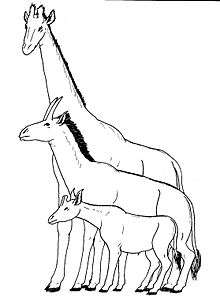Samotherium
| Samotherium Temporal range: Miocene to Pliocene | |
|---|---|
| | |
| Samotherium boissieri skull | |
| Scientific classification | |
| Kingdom: | Animalia |
| Phylum: | Chordata |
| Clade: | Synapsida |
| Class: | Mammalia |
| Order: | Artiodactyla |
| Family: | Giraffidae |
| Genus: | †Samotherium |
| Species | |
| |
Samotherium ("beast of Samos") is an extinct genus of giraffe from the Miocene and Pliocene of Eurasia and Africa. Samotherium had two ossicones on its head, and long legs. The ossicones usually pointed upward, and were curved backwards, with males having larger, more curved ossicones, though, in the Chinese species, S. sinense, the straight ossicones point laterally, not upwards. The genus is closely related to Shansitherium.
According to biologist Richard Ellis, the skull of a Samotherium is portrayed on an ancient Greek vase as a monster that Heracles is fighting.[1]
Description

Samotherium major (middle) in comparison with the okapi (below) and giraffe. The anatomy of Samotherium appears to have shown a transition to a giraffe-like neck.

S. major and S. boissieri
A 2015 study found that Samotherium had a neck intermediate in length between the giraffe and the okapi, judging from examination of specimens of S. major from Greece.[2]
References
- ↑ Ellis, Richard (2004). No Turning Back: The Life and Death of Animal Species. New York: Harper Perennial. p. 6. ISBN 0-06-055804-0.
- ↑ http://rsos.royalsocietypublishing.org/content/2/11/150521
This article is issued from Wikipedia - version of the 11/10/2016. The text is available under the Creative Commons Attribution/Share Alike but additional terms may apply for the media files.